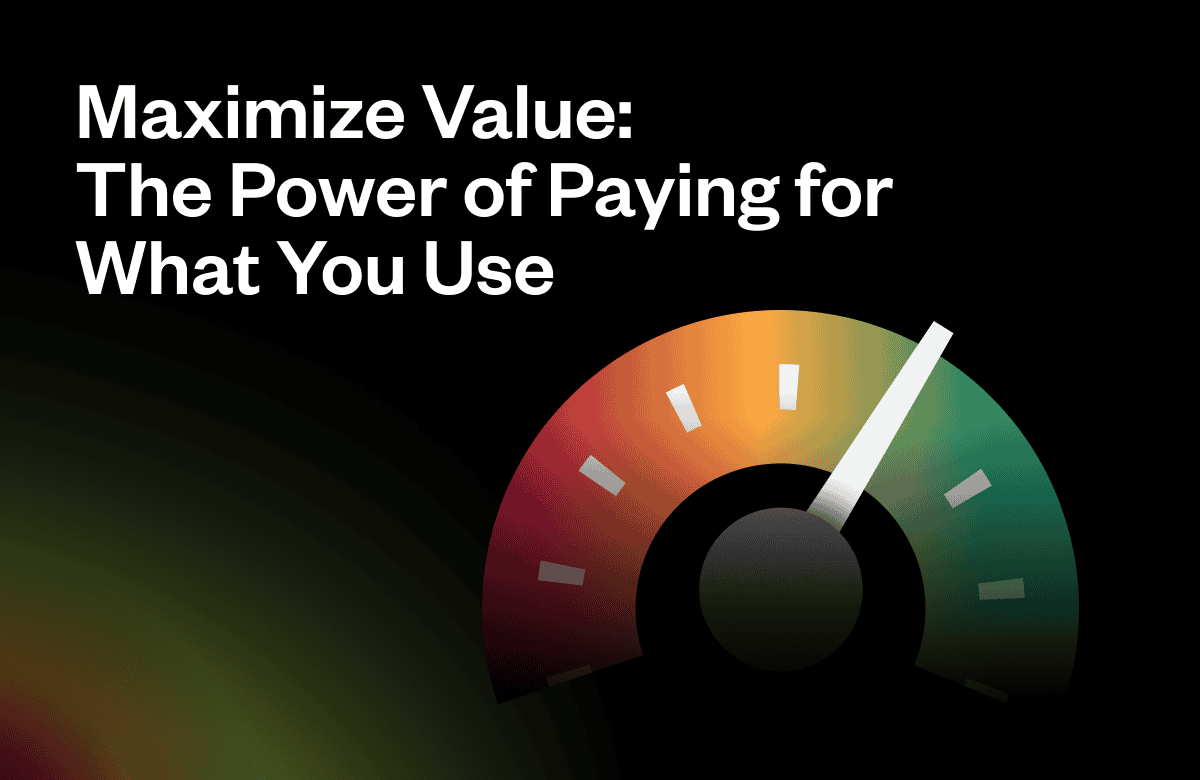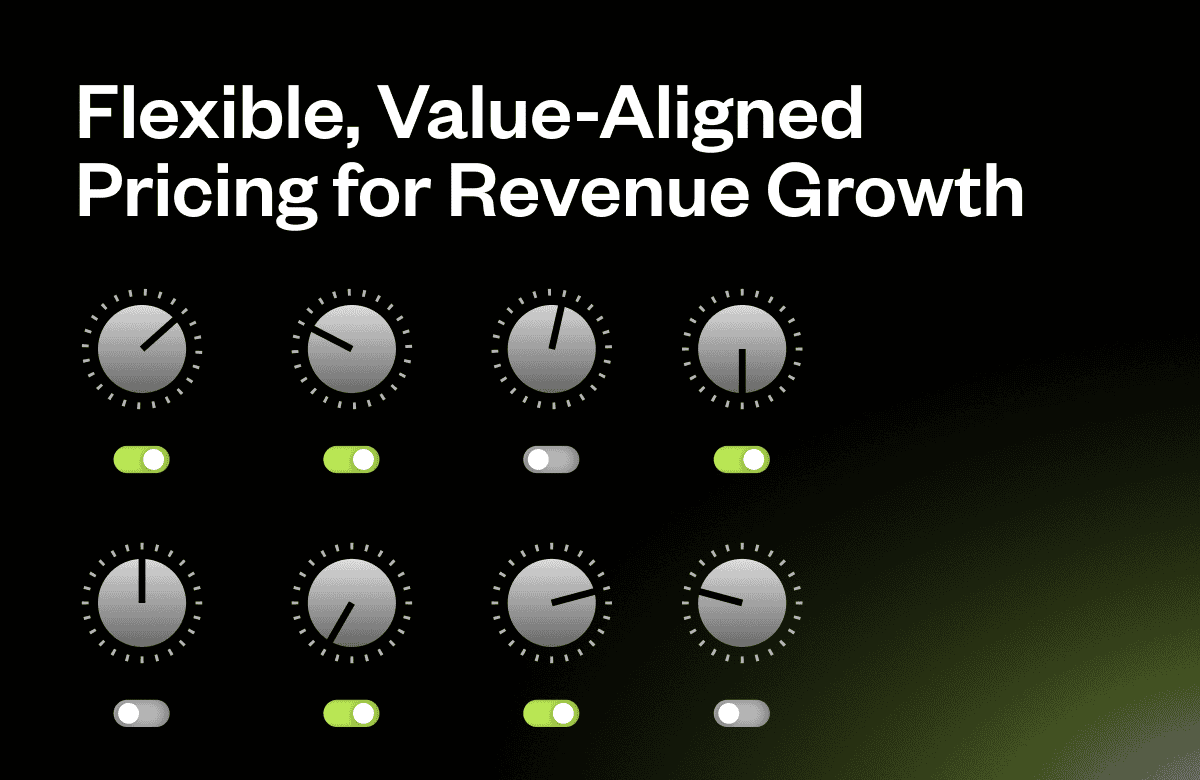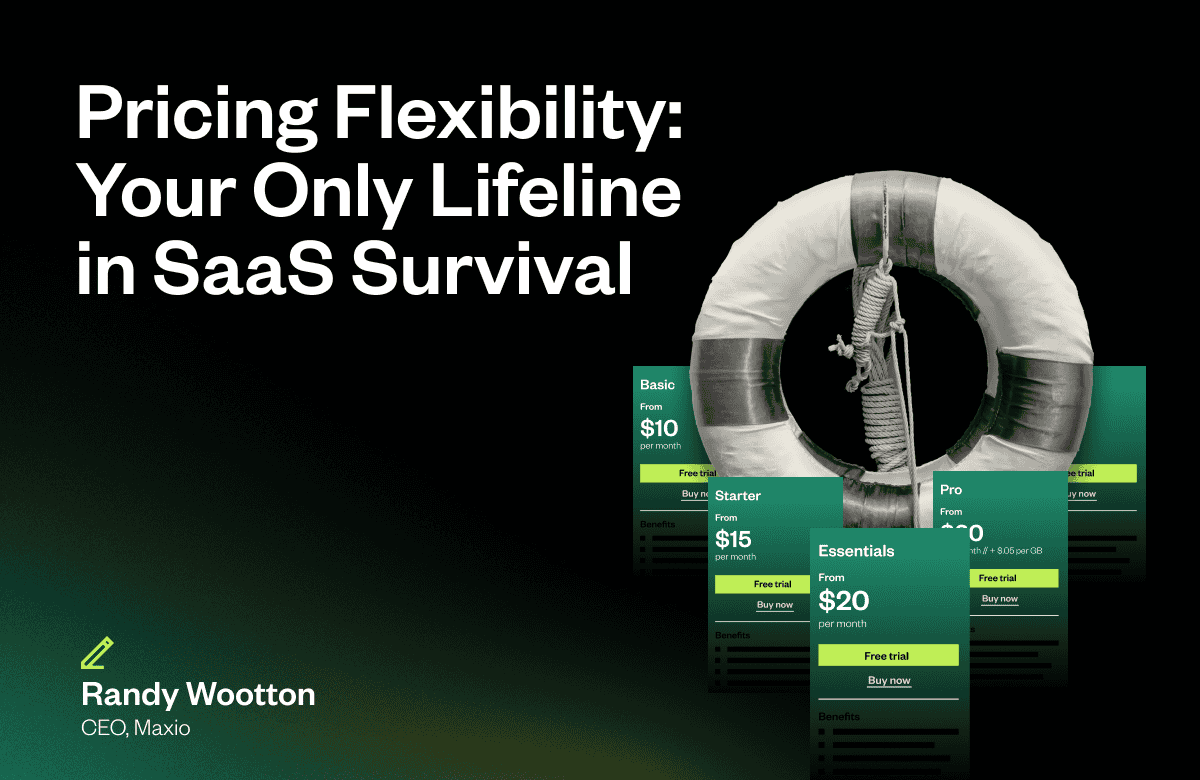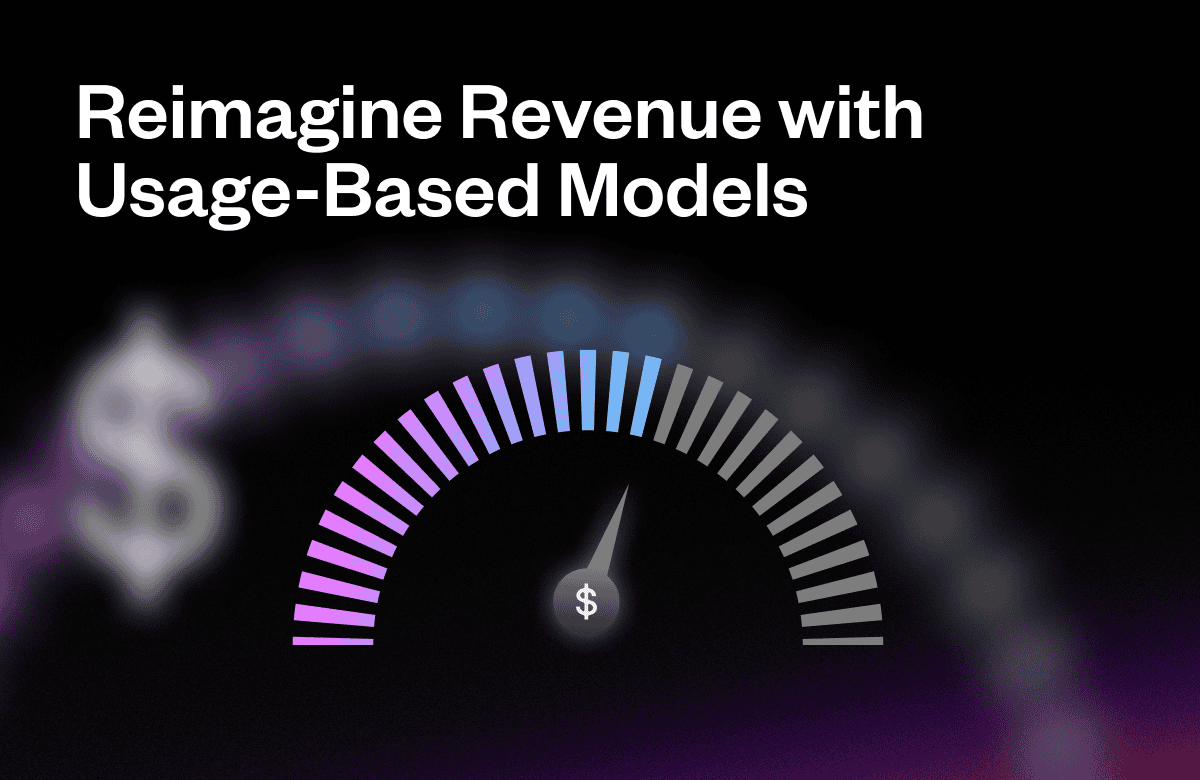For any SaaS company, implementing the right subscription-based pricing model is crucial to its potential profitability and scalability. Choose the wrong pricing model, and you can unintentionally leak revenue or curb your own growth efforts.
But how do you know which approach is the best fit for your business?
In this article, we’ll explore one increasingly popular model, consumption-based pricing, including its major benefits and examples of SaaS companies using it effectively. You’ll also learn key considerations around metering usage, calculating your costs per transaction, and structuring tiered usage-based pricing plans in your business.
What is consumption-based pricing (aka usage-based pricing)?
Consumption-based pricing bills customers based on their actual product usage or the resources they consume, rather than a flat rate.
This customer-centric pricing structure is commonly used in cloud services, hosting, IT, telecom, and other subscription-based or metered usage industries. And for SaaS companies especially, a consumption model can align costs more directly to customer usage and value.
Curious if a consumption-based model is right for your business? Here are just a few situations and use cases where consumption pricing works well:
- Companies with wide variations in usage per customer
- Companies with Customers that insist on paying only for capacity actually used
- Companies that seek to deploy a “try before you buy” model
- Companies with variable costs that scale predictably with product usage
The consumption-based approach provides flexible alignment between usage and costs for both SaaS companies and their users. But the model requires careful implementation around metering, tiering, and cost-per-transaction calculations.
How do consumption-based pricing models work?
At its core, a consumption pricing model charges users based on their actual product usage. But first, this usage has to be defined using what’s called “value metrics.” And using a dedicated billing platform like Maxio, SaaS companies can track these value metrics like storage consumed, bandwidth used, transactions processed, or any other activity you want to tie your customers’ usage to.
These consumption-based models can then be layered on top of other popular SaaS pricing methods, including:
- Pay-As-You-Go: Customers pay for their exact usage with no minimum fees, which is useful for customers with intermittent needs.
- Pre-Paid Commitments: Customers pay for their projected usage up front, then are either prompted to “re-up” or roll on to a new model once they’ve exceeded their usage limit.
- Tiered Subscriptions: Usage is divided into pricing tiers based on usage thresholds. Higher usage levels typically cost more per unit under this method, and customers can use these tiers to budget accordingly.
- Overage Fees: With overage fees, there is a set amount of included usage per billing cycle. Customers pay the regular rate up to that threshold. However, if their usage goes over the limit, they pay an extra per-unit rate for that additional activity above the cutoff. These fees help customers anticipate some degree of costs while capping unexpected expenses if their usage spikes in a given month.
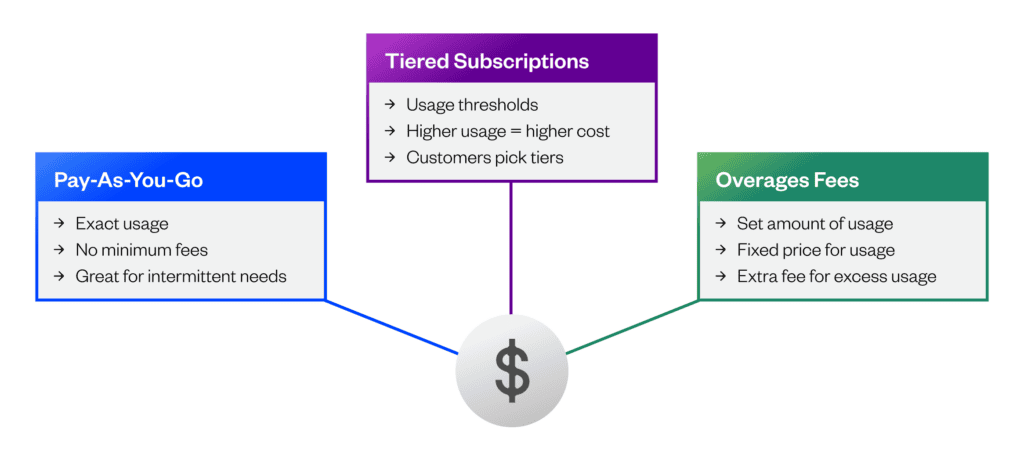
Benefits of consumption-based pricing
Just like with any other pricing model, a consumption-based method isn’t right for every SaaS business. However, if you do decide to implement a consumption model, here are some of the usage-based pricing benefits you can expect:
- Greater Value Alignment: Aligning your customers’ costs directly to the value you’re providing greatly improves the user experience and builds trust. This is because customers feel that your pricing matches the utility they get from the product.
- Flexibility & Scalability: The usage-based pricing model adapts easily to customers’ changing business needs. Customers can scale up during busy periods and scale back down without paying for unused capacity. And this flexibility provides more value to your customers, resulting in less churn and greater customer retention.
- Built-in Expansion Opportunity: SaaS businesses are always optimizing for improving product adoption. The beauty of consumption-based models is that organic efforts in driving adoption will help power your NRR without necessarily selling anything new to your existing customers.
- Insightful Usage Data: Metered billing provides valuable usage data that SaaS companies can analyze to improve their products, marketing, and target customer needs. Consumption analytics helps providers optimize packaging and pricing strategies over time.
Despite all the benefits listed here, you should remember that this model requires careful planning regarding your metering, tiering, and cost-per-use calculations. To do this, you could try to manage this disjointed data across multiple platforms, or you could use a dedicated billing platform like Maxio to automatically track and calculate your usage data.
Challenges of consumption-based pricing
Now that we’ve touched on all the reasons why implementing a consumption-based model is potentially a great choice for your SaaS business, we need to level your expectations. Usage-based models aren’t a silver bullet for growth, and they come with several strings attached. Here are just a few of the challenges of consumption-based pricing you should be aware of:
- Possible Cash Flow Volatility: Unlike the predictable recurring revenue you get from fixed subscriptions, consumption pricing can vary widely month-to-month based on metered usage. This makes revenue forecasting and reliable cash flow projections more difficult for both SaaS businesses and their customers. You’ll need to analyze past usage data and build models to estimate these expected revenue ranges to get a handle on your future cash flow and give customers a realistic view of how much they can expect to pay over time.
- Over-Optimizing Usage: Customers who are motivated to maximize savings may find ways to artificially reduce their metered usage, working around your intended value metrics. If you want to avoid this, you’ll need to continually assess your usage reports for odd customer usage patterns or include mechanisms such as monthly minimum fees to ensure continuation of fees in low usage periods.
- Longer Sales Cycles: Explaining the mechanics of consumption pricing can add complexity to sales discussions, especially around usage metrics and tiered pricing trade-offs. This may extend deal cycles for some prospects who are unfamiliar with usage-based billing. Your sales reps will need to set proper expectations around your measurement approaches upfront to minimize these delays.
- Internal Alignment on Process and KPIs: Introducing a consumption-based model necessitates a SaaS business to answer important questions on how success is defined and awarded, especially in cases where there are existing processes and KPIs in place for subscription revenue streams. Defining key KPIs, like ARR, NRR, and GRR, can help you align processes like sales compensation administration to this new model.
In short, it takes ongoing iterations, workshopping, and refinement to establish financial operations processes, tune the GTM motion, and configure the right usage metrics and pricing details for your consumption models. But as long as you set these expectations upfront and leverage dedicated billing tools, you can reap the full benefits of this pricing model.
How to implement a consumption-based pricing model
Determining whether or not a consumption-based pricing model is right for you is one thing. But knowing how to implement it into a growing SaaS business is a feat of its own. Here are the steps you should follow if you want to start using a consumption-based model.
Determine whether this model is right for you (or go hybrid)
Before implementing consumption-based pricing, you should evaluate if the model makes strategic sense based on your current go-to-market motion. You can start by assessing usage-based pricing factors like your existing revenue streams, customer usage patterns, billing capabilities, market dynamics, and sales bandwidth to support a new pricing approach.
For some organizations, however, blending both fixed and dynamic pricing into a hybrid model helps balance predictability with flexibility, making it a good option if you don’t want to go all in on usage-based pricing. You’ll also want to carefully weigh these pricing factors against your business model, customer profile, and capabilities to determine if going all-in on consumption pricing, or taking a hybrid approach, aligns better with your situation.
Define your consumption metric(s) and pricing type
If you’ve decided to go ahead with consumption billing, great! Your next step will be to determine what value metrics to measure for usage. A few possibilities could include cloud computing resources consumed, number of users per month, API calls made, bandwidth used, or whatever specific value metrics align best with your core features and services.
Ensure pricing transparency
Unlike a flat rate or traditional subscription, consumption pricing can seem complex to customers who are unfamiliar with usage-based billing. To eliminate any confusion, you should clearly communicate how the model works upfront and provide transparency into your value metrics and how costs are calculated. For instance, you could give your users access to a pricing calculator that helps them estimate their bills based on sample usage. Similarly, you could provide them with a self-service dashboard that highlights their historical consumption and charges in an easy-to-understand format. And did we mention that you can mention both of these in Maxio? Check it out!
Implement tracking and billing tools
If you want to successfully execute a consumption-based pricing strategy, you’ll need robust systems to track usage, process billing, and recognize revenue. And to do that you’ll also need real-time metering to capture customer usage activity across your chosen value metrics.
But that’s just the tip of the iceberg. Even after you’ve successfully set up your metering, you’ll also need billing management tools to streamline your subscription management, invoicing, collections, and revenue recognition based on consumption. Of course, you could try to manage this data manually in a spreadsheet, but then you’re opening yourself up to all kinds of data errors which can have serious downstream consequences for your business (especially when audit time rolls around).
Pilot the model, collect feedback, and optimize
Once you’re ready to get started with this model, you’ll then want to test consumption pricing with a small customer segment first before rolling it out broadly across your business.
Monitor usage trends, billing accuracy, revenue fluctuations, and any customer feedback you get during this period. Then, track where expected usage or revenue differs from actuals to improve your revenue forecasting models. You can also use customer input collected from your Customer Success team to identify any points of confusion and refine your messaging around the benefits of your company’s consumption-based model.
This is not a small undertaking by any means. But starting small like this and then optimizing based on real data and user input will help you set up a pricing model that’s both sustainable and profitable.
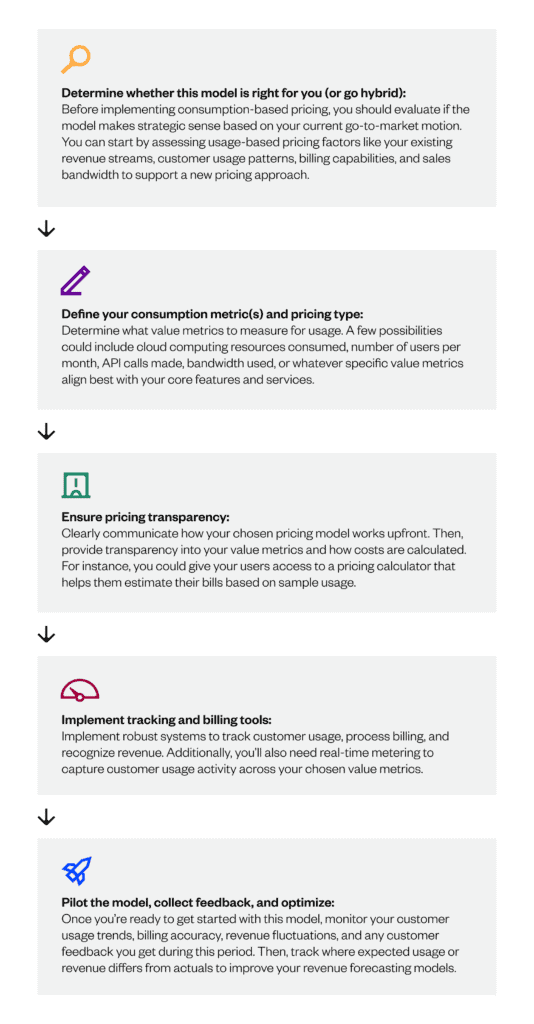
Examples of SaaS companies that use consumption-based pricing
It’s hard to imagine success with a new pricing model unless you have real evidence that it works. Fortunately, there are dozens and dozens of SaaS companies who have successfully implemented consumption-based pricing. Here are just two usage-based billing SaaS examples that highlight the benefits of consumption-based pricing.
Amazon Web Services (AWS)
As one of the first and largest cloud computing platforms, Amazon Web Services (AWS) relies completely on usage-based pricing for its wide range of infrastructure, platform, and application services. The pay-as-you-go approach bills customers only for actual consumption of resources like computing time, data storage, and outbound data transfers.
For example, with EC2 virtual machines, clients pay per second that instance, families and sizes are running based on the capacity. And with their S3 cloud storage, AWS charges for gigabytes stored, access requests, and outbound data transfer fees. Plus, its serverless Lambda service meters total function executions and compute time. Across all of these services, AWS’s clients can scale up seamlessly during traffic spikes and scale down during lighter loads — only paying for the resources they’re actively using.
The AWS consumption model provides direct visibility into month-to-month variable costs while allowing their customers to dynamically align usage to their workloads. This kind of pricing flexibility is what has made AWS the leader in public cloud adoption that it is today.
Zapier
If you aren’t already familiar with this leader in the automation space, Zapier is a popular workflow automation tool for small businesses, and it uses pre-built integrations called “zaps” to connect web apps like Gmail, Slack, Facebook, and Salesforce. At its core, the platform’s pricing relies on a usage-based model tied directly to the number of tasks executed.
A “task” in Zapier constitutes any single step in an automation process (like creating a new spreadsheet row, sending an email, or posting social media updates for example). As users create these multi-step workflows called “zaps,” they are billed monthly based on how many actions those zaps perform across integrated apps.
Zapier also offers tiered plans based on expected task volume like 500, 1,500 or 5,000+ tasks per month. While light users may do fine on the free tier, power users pay more only when they drive higher usage. There are also premium add-ons for features like custom code scripts or priority support. In other words, Zapier’s smart approach to consumption pricing puts both their customers and themselves in a winning position.
Implementing consumption-based pricing for your SaaS business
Whatever your use case, business model, or customer needs, if you want to implement usage based pricing in SaaS, then you need a dedicated billing solution.
At Maxio we designed our platform specifically with SaaS companies in mind, allowing you to launch new pricing models, streamline collections and revenue recognitions, and access metrics on your company’s financial performance all in one place.
Ready to launch your consumption-based pricing model? Schedule a demo to get started.

